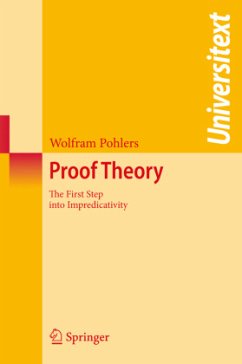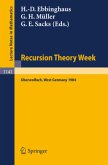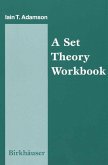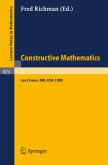This book on proof theory needs no previous knowledge of proof theory. Avoiding cryptic terminology as much as possible, it starts at an elementary level and displays the connections between infinitary proof theory and generalized recursion theory.
The kernel of this book consists of a series of lectures on in?nitary proof theory which I gave during my time at the Westfalische ¨ Wilhelms-Universitat ¨ in Munster ¨ . It was planned as a successor of Springer Lecture Notes in Mathematics 1407. H- ever, when preparing it, I decided to also include material which has not been treated in SLN 1407. Since the appearance of SLN 1407 many innovations in the area of - dinal analysis have taken place. Just to mention those of them which are addressed in this book: Buchholz simpli?ed local predicativity by the invention of operator controlled derivations (cf. Chapter 9, Chapter 11); Weiermann detected applications of methods of impredicative proof theory to the characterization of the provable recursive functions of predicative theories (cf. Chapter 10); Beckmann improved Gentzen's boundedness theorem (which appears as Stage Theorem (Theorem 6. 6. 1) in this book) to Theorem 6. 6. 9, a theorem which is very satisfying in itself - though its real importance lies in the ordinal analysis of systems, weaker than those treated here. Besides these innovations I also decided to include the analysis of the theory (? -REF) as an example of a subtheory of set theory whose ordinal analysis only 2 0 requires a ?rst step into impredicativity. The ordinal analysis of(? -FXP) of non- 0 1 0 monotone? -de?nable inductive de?nitions in Chapter 13 is an application of the 1 analysis of(? -REF).
The kernel of this book consists of a series of lectures on in?nitary proof theory which I gave during my time at the Westfalische ¨ Wilhelms-Universitat ¨ in Munster ¨ . It was planned as a successor of Springer Lecture Notes in Mathematics 1407. H- ever, when preparing it, I decided to also include material which has not been treated in SLN 1407. Since the appearance of SLN 1407 many innovations in the area of - dinal analysis have taken place. Just to mention those of them which are addressed in this book: Buchholz simpli?ed local predicativity by the invention of operator controlled derivations (cf. Chapter 9, Chapter 11); Weiermann detected applications of methods of impredicative proof theory to the characterization of the provable recursive functions of predicative theories (cf. Chapter 10); Beckmann improved Gentzen's boundedness theorem (which appears as Stage Theorem (Theorem 6. 6. 1) in this book) to Theorem 6. 6. 9, a theorem which is very satisfying in itself - though its real importance lies in the ordinal analysis of systems, weaker than those treated here. Besides these innovations I also decided to include the analysis of the theory (? -REF) as an example of a subtheory of set theory whose ordinal analysis only 2 0 requires a ?rst step into impredicativity. The ordinal analysis of(? -FXP) of non- 0 1 0 monotone? -de?nable inductive de?nitions in Chapter 13 is an application of the 1 analysis of(? -REF).
From the reviews:
"Proof Theory takes various axiom systems ... that treat induction in different ways and analyzes them from the ordinal viewpoint to gauge their relative strengths. ... This new version includes several developments in the field that have occurred over the twenty years since the original. Although the current book, appearing in the Universitext series, claims to be 'pitched at undergraduate/graduate level,' an undergraduate course out of Proof theory would be ambitious indeed." (Leon Harkleroad, The Mathematical Association of America, March, 2009)
"The book is addressed primarily to students of mathematical logic interested in the basics of proof theory, and it can be used both for introductory and advanced courses in proof theory. ... this book may be recommended to a larger circle of readers interested in proof theory." (Branislav Boricic, Zentrablatt MATH, Vol. 1153, 2009)
"This is a textbook-an excellent one-on proof theory, starting from the very elementary (heuristic accounts of sets, ordinals, logic, etc.), and going into a sophisticated area (impredicativity). ... The author's main tool is enquiry into truth complexity and ordinal analysis." (M. Yasuhara, Mathematical Reviews, Issue 2010 a)
"Proof Theory takes various axiom systems ... that treat induction in different ways and analyzes them from the ordinal viewpoint to gauge their relative strengths. ... This new version includes several developments in the field that have occurred over the twenty years since the original. Although the current book, appearing in the Universitext series, claims to be 'pitched at undergraduate/graduate level,' an undergraduate course out of Proof theory would be ambitious indeed." (Leon Harkleroad, The Mathematical Association of America, March, 2009)
"The book is addressed primarily to students of mathematical logic interested in the basics of proof theory, and it can be used both for introductory and advanced courses in proof theory. ... this book may be recommended to a larger circle of readers interested in proof theory." (Branislav Boricic, Zentrablatt MATH, Vol. 1153, 2009)
"This is a textbook-an excellent one-on proof theory, starting from the very elementary (heuristic accounts of sets, ordinals, logic, etc.), and going into a sophisticated area (impredicativity). ... The author's main tool is enquiry into truth complexity and ordinal analysis." (M. Yasuhara, Mathematical Reviews, Issue 2010 a)








